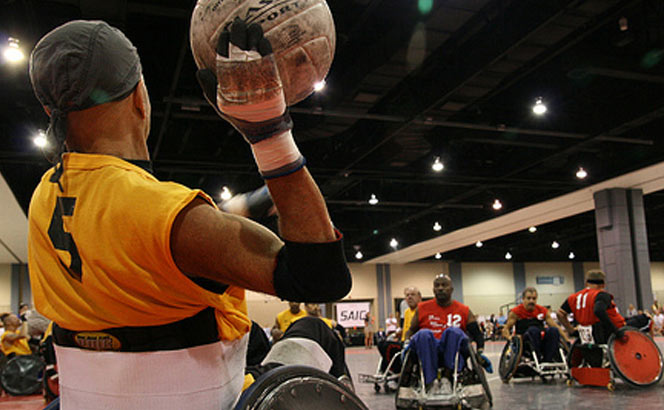Murderball. It sounds intimidating, frightening and intense. It’s a name that captures the high-energy, full-contact sport that is wheelchair rugby, a sport with a huge fan following that is the subject of an Academy Award-nominated documentary. And it’s a must watch in this year’s upcoming Paralympic Games in London, set to kick off next week.
Before the games can begin, however, international evaluators like Anne Hart, Northern Arizona University associate professor of physical therapy and athletic training, must assess athletes and classify them by ability.
Hart’s evaluation duties this year will focus on athletes competing in wheelchair rugby. She’ll look at an athlete’s strength and motion related to the sport—for instance, an individual’s ability to pick up a ball with one hand.
“Rugby is so much fun that other athletes want to play,” she said. “It is such a great spectator sport because of the contact and crashes.”
| Games bring about cultural shift; veterans grab opportunities Anne Hart has seen the cultural shift that can come about as a result of Paralympic sport. The NAU associate professor of physical therapy and athletic training is one of 40 individuals qualified to evaluate athletes for international competition and has volunteered in that capacity at several Paralympic Games. In Beijing, tickets to the 2008 Olympic Games were too expensive so locals bought tickets to the Paralympic games instead. But Chinese Paralympic athletes weren’t used to the support of a home crowd. “A crowd of 10,000 attended when China played wheelchair rugby, and the players on the court had tears in their eyes,” Hart said. In the United States, the Paralympics are serving as a path for disabled veterans from the wars in Afghanistan and Iraq to transition back into an active life. Hart said wounded warrior programs and the U.S. Department of Veterans Affairs have been instrumental in steering veterans with amputations and brain injuries toward sport for mental and physical rehabilitation. Eight percent of the athletes who participated in the Paralympics for the United States in 2008 were veterans, and that is expected to increase to 10 percent in London this year. |
There are seven classes for wheelchair rugby, with the highest being for those with the least impairment. And all athletes must have some weakness in their arms and legs yet be able to push a wheelchair on their own.
While much discussion in this year’s Olympics focused on South African Oscar Pistorius’s carbon fiber blades and the technology behind them that enables him to compete, the evaluation of athletes for the Paralympics is focused on each individual’s ability. None of the criteria that divide athletes into categories examines their equipment and what advantage, or disadvantage, may exist.
Likewise, the lessons Hart brings back to the classroom are not of actuators or streamlined wheelchairs, but the role that sport can play in rehabilitation.
“I get to see what impact sport has on athletes for the rest of their lives,” she said. “I see these athletes, and they are similar to someone our students will eventually work with in rehabilitation. They’re dealing with what they lost. Many of these athletes will tell you their lives are rich and better than before—they aren’t worried about their loss, they’re focused on winning.”
The perspective that Hart brings, the experience she has with working with the highest level of international athletes, helps students see a broad range of options for their patients.
“By bringing sport in to the classroom, I show students what is possible,” Hart said. “They begin to see they can make such a difference in a patient’s life. It’s about ability, not disability.”



